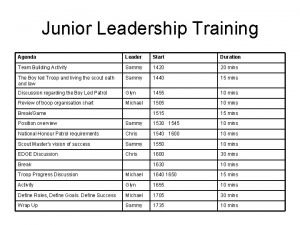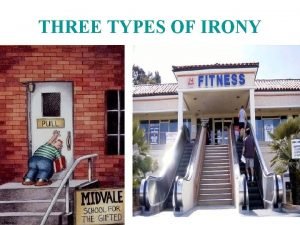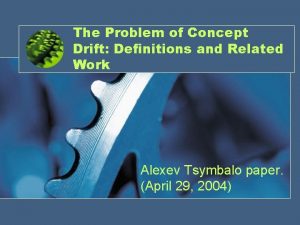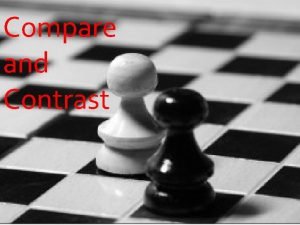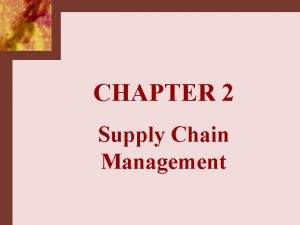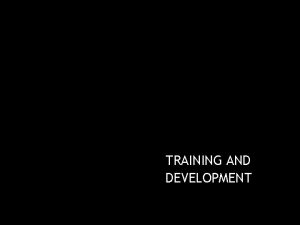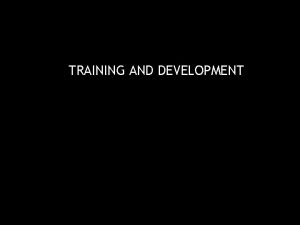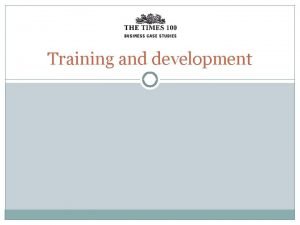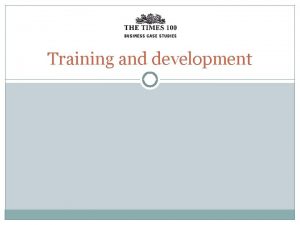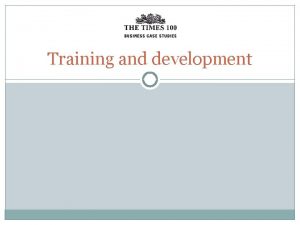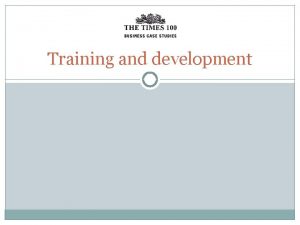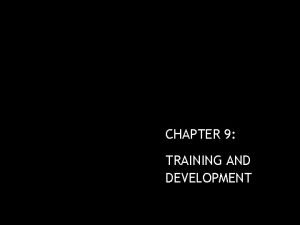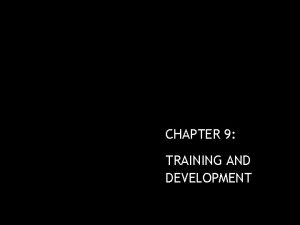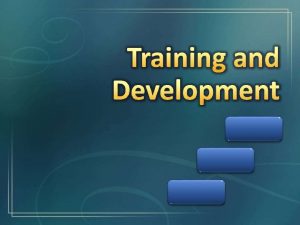TRAINING AND DEVELOPMENT Lecture 4 Agenda Training Definitions














- Slides: 14

TRAINING AND DEVELOPMENT Lecture 4

Agenda � Training � Definitions � Stages and steps � Goals and concerns

Training � “The systematic development of the knowledge, skills and attitudes required by an individual to perform adequately a given task or job” � Michael Armstrong

Reasons � � � To develop competent employees To develop skills and abilities To develop knowledge

Training Stages � Stage 1 – Identifying the need (Thayer and Mc. Ghee model) � Organization analysis Understanding the mission and the goal of the organization �Excellent customer service � Job analysis Detailed examination of the job �Observations � Individual analysis Feedback from employees and managers Interviews

Who is responsible for training � Training department � Orientations and Inductions � Executive development � Supervisor � On the job training How to use specific machinery

Training Stages � Stage 2 – developing the trainings � Goal is in 3 phases: � Cognitive phase -> associative phase -> autonomous phase Cognitive �Learning definitions Associative �Definitions become routine Autonomous �Definitions become automatic/reflex

Training Stages � In order to achieve 3 phases we must: � Start with basic information and build it from there � Start involving employees and ensure them that they can perform the task to motivate � Provide extensive feedback � Provide hands of practice with simulations � Slowly move the practice to actual work from simulations

Types of trainings � On the job training � Learning by doing the real work By supervisors �Saves time and cost �Can be difficult and stressful � Off the job training � Learning in a classroom as a group By trainers �Smooth transition from class to work �Can be time consuming and costly � Internships

Training Stages � Stage 3 – Delivering � By supervisor on the job method � By trainers in the organization � By hired trainers (outsourcing)

Training Stages � Stage 4 – Evaluation � Satisfaction test Survey � Knowledge test Written test after training � Behavior test Performance appraisal � Result test Impact on the organization through costs and profits

Issues with training � Sometimes trainings might be in effective due to : � Unclear type of training provided � Simulation trainings might be unrelated to the job � No reward for trainers

Resources � � * Armstrong’s Handbook of HRM Practice * Human Resource Management (Derek Torrington et al. )

 01:640:244 lecture notes - lecture 15: plat, idah, farad
01:640:244 lecture notes - lecture 15: plat, idah, farad Agenda sistemica y agenda institucional
Agenda sistemica y agenda institucional Global agenda for social work and social development
Global agenda for social work and social development Leadership training agenda
Leadership training agenda Different types of irony
Different types of irony The problem of concept drift: definitions and related work
The problem of concept drift: definitions and related work Carburizing flame definition
Carburizing flame definition How to measure for birdsmouth cut
How to measure for birdsmouth cut Material properties and definitions
Material properties and definitions Build your vocabulary find these words in the text
Build your vocabulary find these words in the text What are the 8 news values
What are the 8 news values What is the definition of compare and contrast
What is the definition of compare and contrast Cscmp logistics definition
Cscmp logistics definition Has no dimension; is one of the undefined terms of geometry
Has no dimension; is one of the undefined terms of geometry A conical drum of maranao
A conical drum of maranao



